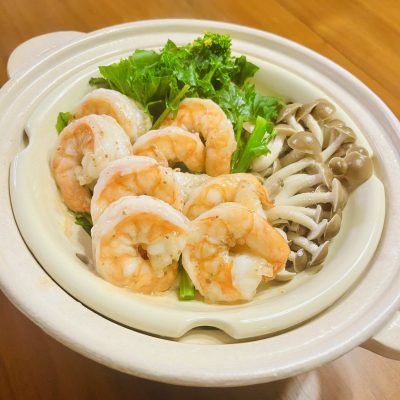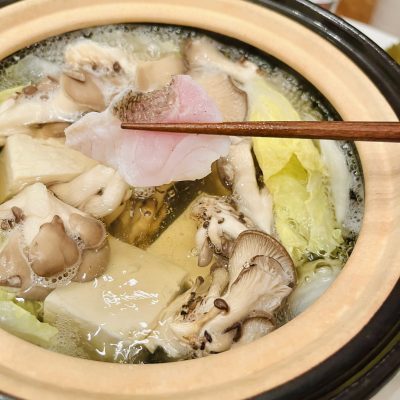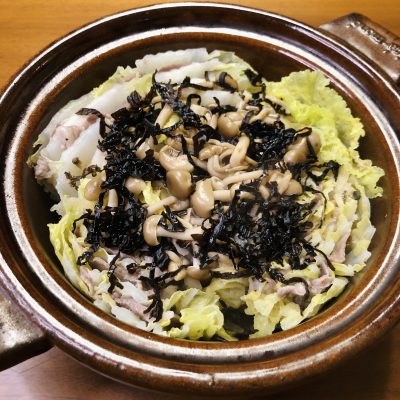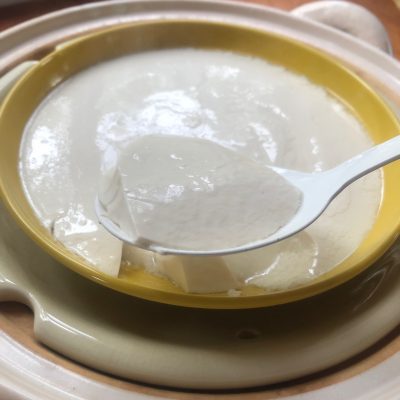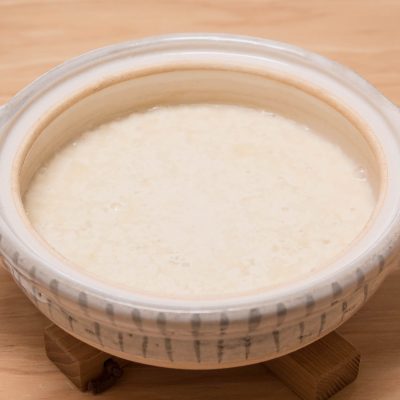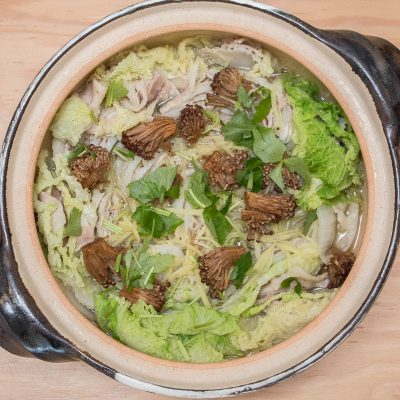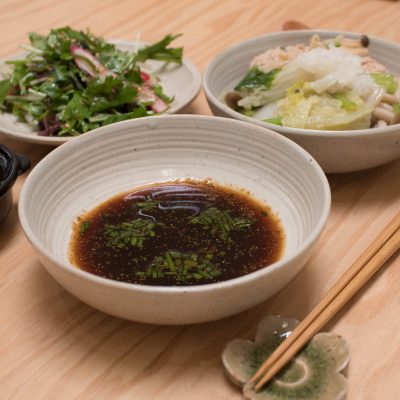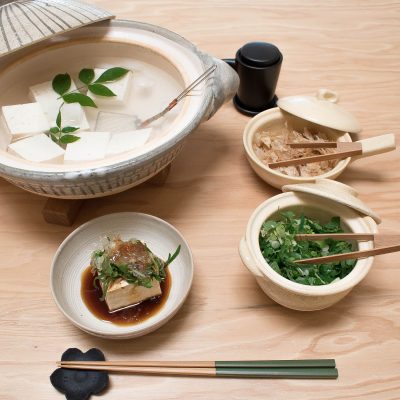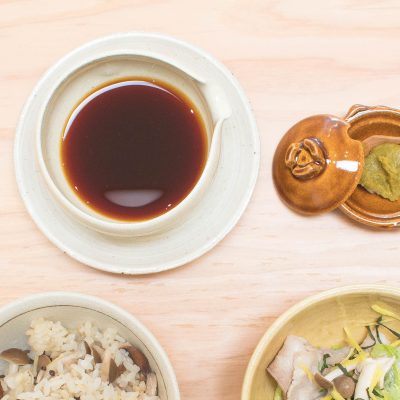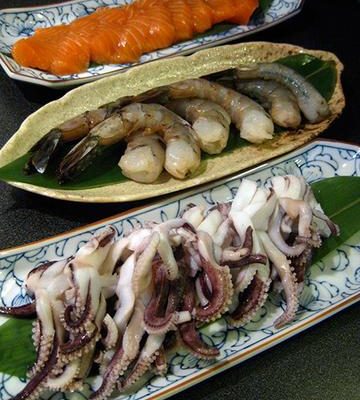Simple donabe steamed shrimp and rapini is almost a non-recipe dish and always delightful. I like to serve with my homemade Yuzu Ponzu (recipe in my DONABE Cookbook). If you opt for a ready-made ponzu, we have great ones in our pantry section, too. Sansho and sake enhances the flavor and sansho adds the nice subtle citrusy kick. The addition of katakuriko (potato starch), although it’s optional, seals the flavors and the helps the texture to be so plump.
Tag Archives: Ponzu
Sea Bream Shabu Shabu
Spring really makes me want to eat Tai (sea bream) every day. I enjoy it in sashimi, carpaccio, sushi, etc. And, here’s another Tai dish I love, which is Tai Shabu. It’s basically a simple fish shabu shabu and always so good. If you can save enough broth, hope you enjoy the shime (finishing) noodle course, too.
Steamed Pork and Cabbage Shabu Shabu
This steamed donabe dish is so tasty and nourishing. The thinly-sliced pork and cabbage always make a great flavor combination. The ingredients are simply steamed in a donabe steamer, Mushi Nabe for 4 – 5 minutes and served with pre-prepared ponzu and garlic miso dipping sauces. Feel free to substitute any ingredients to steam and enjoy!
Shio-Kombu Pork & Napa Cabbage Mille Feuille
This is such a simple dish as all I need to do is to pile up napa cabbage and pork slices (this time, I used pork shoulder, but pork belly is also good), cut them and stuff in a donabe . The seasoning is basically just the Shio-Kombu, and it releases so much umami flavors to the dish! The donabe cooks the ingredients evenly in just 15 – 20 minutes over stovetop, and you don’t need to do anything to it, meanwhile. Both the napa cabbage and pork become so tender!
The dish is already so tasty on its own, but I like to drizzle a small amount of ponzu or a dab of yuzu-kosho.
Tuna Hot Pot
One day, a very good customer of ours stopped by at our shop to give us a block of fresh tuna he just caught from fishing in the Pacific Ocean. How sweet of him! It was super fresh sashimi quality, so we tried some as sashimi with different kinds of soy sauces we have, then for the remaining, I decided to make a donabe hot pot with it. Tuna hot pot in donabe is a popular dish in Japan, and it’s typically made as a combination with negi (Japanese green onion). It’s called Negi-Ma Nabe. The name is short for Negi (green onion) Maguro (tuna) Nabe (hot pot).
This dish is very simple, and all you need is good quality dashi, tuna (obviously!), green onion (for the name’s sake) and any other ingredients you like to add. I like it with my ponzu.
For the shime (finishing course), I like making quick ojiya (porridge) with freshly-cooked donabe rice.
Homemade Silky Tofu
Homemade Tofu
Authentic fresh tofu can be made at home very easily, once you have a donabe and high quality soymilk. All you need to do is to heat soymilk, stir in nigari liquid, turn off the heat, and rest until the mixture sets to become tofu. Iga-yaki donabe is perfect for fresh tofu making, because the porous body achieves the gentle and even heat distribution. It also cools down very slowly after turning off the heat, so the tofu can set to ideal stage during the resting time. The fresh warm tofu right out of donabe is simply a joy and I always have my first few tastes without any seasonings or condiments. It’s so fluffy, delicate, and pure. Then, I enjoy it with different toppings. Sometimes simply with shaved katsuobushi (shaved dried bonito flakes) and soy sauce, or wasabi, sea salt (such as moshio sea salt), and sesame oil. Ponzu is great, too.
Premium quality Banrai Soymilk and Banrai Nigari Liquid are both available at our shop. So, hope you give it a try. You can make a full-size sukui tofu to share or a small individual-size tofu in a mini-size donabe for everyday breakfast.
The recipe introduced in this page is calling for 1-liter soymilk. For the half amount, you can use a small-size classic-style donabe (approx. 0.8-qt/ 800 ml size). The photos below are made with small-size Rikyu-Tokusa donabe.
For an idividual-size silky tofu making method, please see Banrai Soymilk and Banrai Nigari Liquid product page.
Pork and Napa Cabbage Mille Feuille
This dish is all about pork and napa cabbage, cooked in a minimum way. They are simply layered to pack in a donabe, with a small amount of water and sake. There is not even dashi or salt. You can top them with some sliced ginger and mushrooms, and gently simmer for 25 – 30 minutes. The result is a tasty treat rich in umami, and it looks beautiful, too. The soup is also packed with all the natural flavors from the ingredients, so make sure to enjoy it with the dish, too.
I like to serve it with Sansho Ponzu Sauce and Hatcho Miso & Black Sesame Sauce (recipe below) for flavor variations. Or, you can simply serve it with yuzu-kosho or Kanzuri, too.
Shiso Chicken Meatball & Grated Daikon Hot Pot
This dish is packed with nutrients, and so easy to make. It’s also a great dish to enjoy with guests. Chicken meatballs have the very nice subtle shiso flavor and they become fluffy after cooked. I like adding a generous amount of coarsely grated daikon (I highly recommend you use Onioroshi daikon grater for the nice crunchy texture for grating daikon). They give both texture and more flavor to the dish.
For seasoning, I use both white tamari and soy sauce for more complex flavor (and also to keep the broth from becoming too dark), but you can use just soy sauce if you like. You can also adjust the seasoning with extra sea salt at the end. But, please remember, this dish is served with Sansho Ponzu Sauce, so the seasoning should be minimum.
Make sure to save enough broth, so you can enjoy the shime (finishing course) of soba noodles!
Sansho Ponzu Sauce
Combination of soy sauce, daidai citrus and sansho powder (did you know sansho also belongs to citrus family?) create such refreshing bright aroma and kick in this quick dipping sauce. Adjust the amount of sansho powder according to your taste (or tolerance to its numbing heat). Originally introduced to serve with Shiso Chicken Meatball and Grated Daikon Hot Pot, this sauce is good for any hot pot dishes, or as a dipping sauce for gyoza dumplings.
Chilled Tofu with Condiments
Hiyayakko is one of the most simple and beloved Japanese home dishes that is enjoyed all year round. It’s really about simple plain tofu, enjoyed with sliced scallion, shaved katsuobushi, and soy sauce or any condiments of your choice. In the summer time, to make the maximum “cold” effect by both taste and visual, I like to serve the tofu in ice bath in a donabe. Also in this way, you have a beautiful presentation and can even impress your guests. Medium-firm or soft tofu are recommended for hiyayakko, for the most pleasant texture.
Quick Daidai Citrus Ponzu
This is a super simple ponzu, made by equal amount of Japanese daidai citrus (aromatic citrus, which is a type of orange) juice and high quality soy sauce. Great with tofu, grilled fish, etc.

